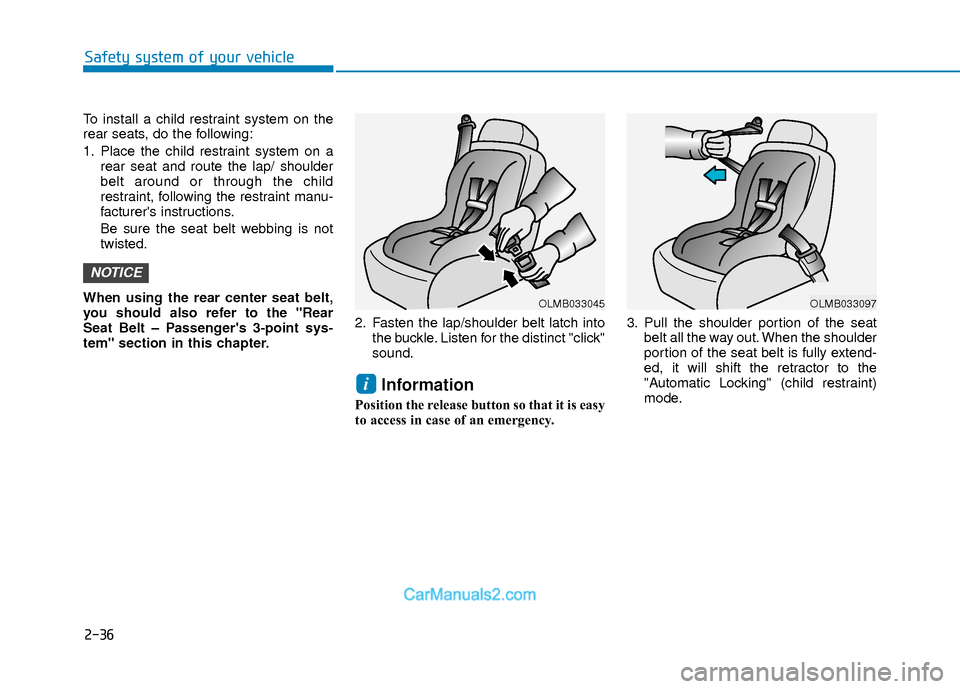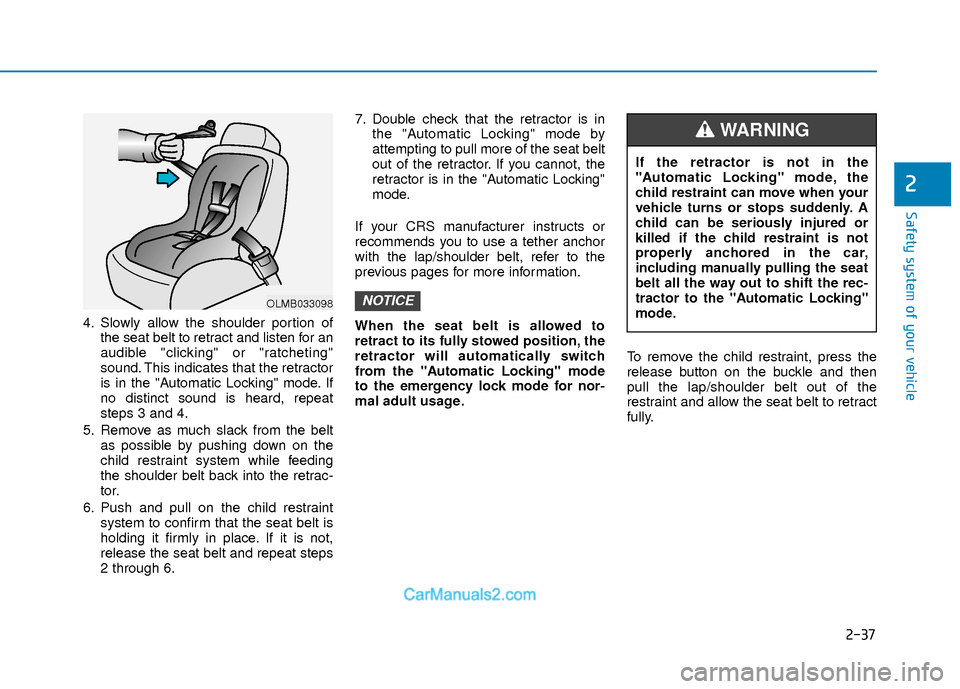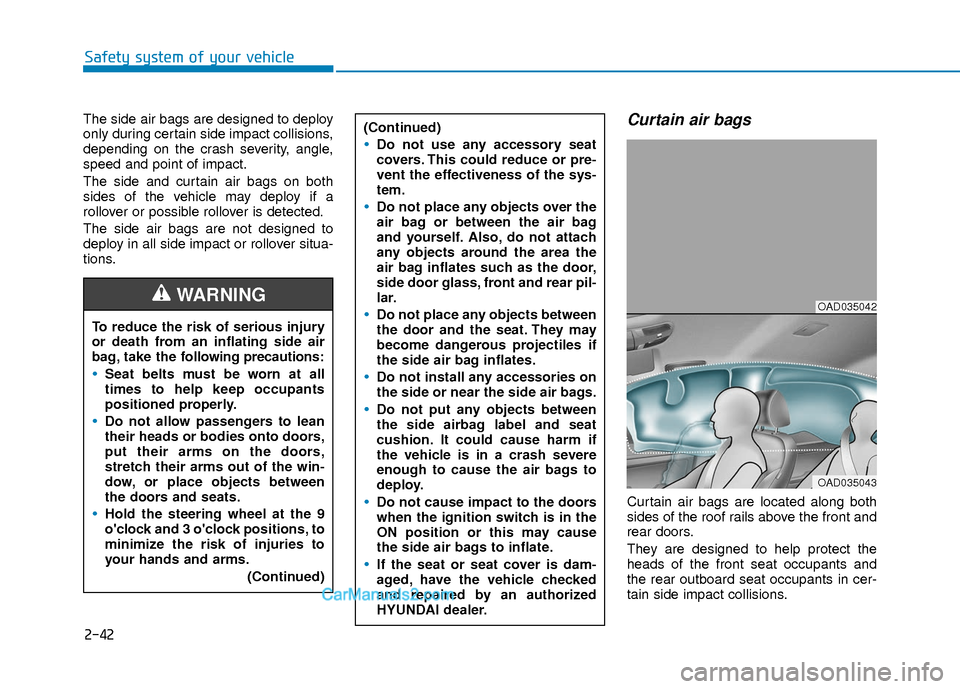2018 Hyundai Elantra lock
[x] Cancel search: lockPage 38 of 526

2-21
Safety system of your vehicle
2
Height adjustment
You can adjust the height of the shoulder
belt anchor to one of the three different
positions for maximum comfort and safe-
ty.
The shoulder portion should be adjusted
so it lies across your chest and midway
over your shoulder nearest the door, not
over your neck.
To adjust the height of the seat belt
anchor, lower or raise the height adjuster
into an appropriate position.
To raise the height adjuster, pull it up (1).
To lower it, push it down (3) while press-
ing the height adjuster button (2).
Release the button to lock the anchor
into position. Try sliding the height
adjuster to make sure that it has locked
into position.
OAD035027
(Continued)
Always position the shoulder belt
anchor into the locked position at
the appropriate height.
Never position the shoulder belt
across your neck or face.
OLMB033025
Improperly positioned seat belts
may increase the risk of serious
injury in an accident. Take the fol-
lowing precautions when adjusting
the seat belt:
Position the lap portion of the
seat belt as low as possible
across your hips, not on your
waist, so that it fits snugly.
Position one arm under the
shoulder belt and the other over
the belt, as shown in the illustra-
tion.(Continued)
WARNING
Page 39 of 526

2-22
Safety system of your vehicle
Rear Seat Belt – Passenger's 3-point system with convertiblelocking retractor
This type of seat belt combines the fea-
tures of both an emergency locking
retractor seat belt and an automatic lock-
ing retractor seat belt. Convertible retrac-
tor type seat belts are installed in the rear
seat positions to help accommodate the
installation of child restraint systems.
Although a convertible retractor is also
installed in the front passenger seat posi-
tion, NEVER place any infant/child
restraint system in the front seat of the
vehicle.
To fasten your seat belt:
Pull the seat belt out of the retractor and
insert the metal tab into the buckle. There
will be an audible "click" when the tab
locks into the buckle. When not securing
a child restraint, the seat belt operates in
the same way as the driver's seat belt
(Emergency Locking Retractor Type). It
automatically adjusts to the proper length
only after the lap belt portion of the seat
belt is adjusted manually so that it fits
snugly across your hips. When the seat belt is fully extended from
the retractor to allow the installation of a
child restraint system, the seat belt oper-
ation changes to allow the belt to retract,
but not to extend (Automatic Locking
Retractor Type). Refer to the "Using a
Child Restraint System" section in this
chapter.
Although the seat belt retractor pro-
vides the same level of protection for
seated passengers in either emer-
gency or automatic locking modes,
the emergency locking mode allows
seated passengers to move freely in
their seat while keeping some tension
on the belt. During a collision or sud-
den stop, the retractor automatically
locks the belt to help restrain your
body.
To deactivate the automatic locking
mode, unbuckle the seat belt and
allow the belt to fully retract.
To release your seat belt:
Press the release button (1) in the lock-
ing buckle.
When it is released, the belt should auto-
matically draw back into the retractor. If
this does not happen, check the belt to
be sure it is not twisted, then try again.
NOTICE
ODH033057
Page 40 of 526

2-23
Safety system of your vehicle
2
Pre-tensioner seat belt (Driver and front passenger)
Your vehicle is equipped with driver's and
front passenger's Pre-tensioner Seat
Belts (Retractor Pretensioner and
Emergency Fastening Device System).
The purpose of the pre-tensioner is to
make sure the seat belts fit tightly against
the occupant's body in certain frontal col-
lisions. The Emergency Fastening Device
System may be activated in certain
crashes where the frontal collision is
severe enough, together with the air
bags. When the vehicle stops suddenly, or if
the occupant tries to lean forward too
quickly, the seat belt retractor will lock
into position. In certain frontal collisions,
the pre-tensioner will activate and pull
the seat belt into tighter contact against
the occupant's body.
(1) Retractor Pretensioner
The purpose of the retractor preten-sioner is to make sure that the shoul-
der belts fit in tightly against the occu-
pant's upper body in certain frontal
collisions.
(2) Emergency Fastening Device System The purpose of the EmergencyFastening Device System is to make
sure that the pelvis belts fit in tightly
against the occupant's lower body in
certain frontal collisions.
If the system senses excessive tension
on the driver or passenger's seat belt
when the pre-tensioner system activates,
the load limiter inside the retractor pre-
tensioner will release some of the pres-
sure on the affected seat belt.
OTL035053
Always wear your seat belt and
sit properly in your seat.
Do not use the seat belt if it is
loose or twisted. A loose or
twisted seat belt will not protect
you properly in an accident.
Do not place anything near the
buckle. This may adversely affect
the buckle and cause it to func-
tion improperly.
Always replace your pre-tension-
ers after activation or an acci-
dent.
NEVER inspect, service, repair or
replace the pre-tensioners your-
self. This must be done by an
authorized HYUNDAI dealer.
Do not hit the seat belt assem-
blies.
WARNING
Page 52 of 526

2-35
Safety system of your vehicle
2
To install the tether anchor:
1. Route the child restraint tether strapover the child restraint seatback.
Route the tether strap under the head
restraint and between the head
restraint posts, or route the tether
strap over the top of the vehicle seat-
back. Make sure the strap is not twist-
ed.
2. Connect the tether strap hook to the tether anchor, then tighten the tether
strap according to the child seat man-
ufacturer’s instructions to firmly
secure the child restraint to the seat.
3. Check that the child restraint is securely attached to the seat by push-
ing and pulling the seat forward-and-
back and side-to-side.
Securing a child restraint withlap/shoulder belt
When not using the LATCH system, all
child restraints must be secured to a
vehicle rear seat with the lap part of a
lap/shoulder belt.
Automatic locking mode
Since all passenger seat belts move
freely under normal conditions and only
lock under extreme or emergency condi-
tions (emergency locking mode), you
must manually pull the seat belt all the
way out to shift the retractor to the
"Automatic Locking" mode to secure a
child restraint.
The "Automatic Locking" mode will help
prevent the normal movement of the
child in the vehicle from causing the seat
belt to loosen and compromise the child
restraint system. To secure a child
restraint system, use the following proce-
dure.
OLF034035
ALWAYS place a rear-facing child
restraint in the rear seat of the vehi-
cle.
Placing a rear-facing child restraint
in the front seat can result in seri-
ous injury or death if the child
restraint is struck by an inflating air
bag.
WARNING
OLMB033044
Page 53 of 526

2-36
Safety system of your vehicle
To install a child restraint system on the
rear seats, do the following:
1. Place the child restraint system on arear seat and route the lap/ shoulder
belt around or through the child
restraint, following the restraint manu-
facturer's instructions.
Be sure the seat belt webbing is not
twisted.
When using the rear center seat belt,
you should also refer to the "Rear
Seat Belt – Passenger's 3-point sys-
tem" section in this chapter. 2. Fasten the lap/shoulder belt latch into
the buckle. Listen for the distinct "click"
sound.
Information
Position the release button so that it is easy
to access in case of an emergency. 3. Pull the shoulder portion of the seat
belt all the way out. When the shoulder
portion of the seat belt is fully extend-
ed, it will shift the retractor to the
"Automatic Locking" (child restraint)
mode.
i
NOTICE
OLMB033045OLMB033097
Page 54 of 526

2-37
Safety system of your vehicle
2
4. Slowly allow the shoulder portion ofthe seat belt to retract and listen for an
audible "clicking" or "ratcheting"
sound. This indicates that the retractor
is in the "Automatic Locking" mode. If
no distinct sound is heard, repeat
steps 3 and 4.
5. Remove as much slack from the belt as possible by pushing down on the
child restraint system while feeding
the shoulder belt back into the retrac-
tor.
6. Push and pull on the child restraint system to confirm that the seat belt is
holding it firmly in place. If it is not,
release the seat belt and repeat steps
2 through 6. 7. Double check that the retractor is in
the "Automatic Locking" mode by
attempting to pull more of the seat belt
out of the retractor. If you cannot, the
retractor is in the "Automatic Locking"
mode.
If your CRS manufacturer instructs or
recommends you to use a tether anchor
with the lap/shoulder belt, refer to the
previous pages for more information.
When the seat belt is allowed to
retract to its fully stowed position, the
retractor will automatically switch
from the "Automatic Locking" mode
to the emergency lock mode for nor-
mal adult usage. To remove the child restraint, press the
release button on the buckle and then
pull the lap/shoulder belt out of the
restraint and allow the seat belt to retract
fully.
NOTICEOLMB033098
If the retractor is not in the
"Automatic Locking" mode, the
child restraint can move when your
vehicle turns or stops suddenly. A
child can be seriously injured or
killed if the child restraint is not
properly anchored in the car,
including manually pulling the seat
belt all the way out to shift the rec-
tractor to the "Automatic Locking"
mode.
WARNING
Page 59 of 526

2-42
Safety system of your vehicle
The side air bags are designed to deploy
only during certain side impact collisions,
depending on the crash severity, angle,
speed and point of impact.
The side and curtain air bags on both
sides of the vehicle may deploy if a
rollover or possible rollover is detected.
The side air bags are not designed to
deploy in all side impact or rollover situa-
tions.Curtain air bags
Curtain air bags are located along both
sides of the roof rails above the front and
rear doors.
They are designed to help protect the
heads of the front seat occupants and
the rear outboard seat occupants in cer-
tain side impact collisions.
(Continued)
Do not use any accessory seat
covers. This could reduce or pre-
vent the effectiveness of the sys-
tem.
Do not place any objects over the
air bag or between the air bag
and yourself. Also, do not attach
any objects around the area the
air bag inflates such as the door,
side door glass, front and rear pil-
lar.
Do not place any objects between
the door and the seat. They may
become dangerous projectiles if
the side air bag inflates.
Do not install any accessories on
the side or near the side air bags.
Do not put any objects between
the side airbag label and seat
cushion. It could cause harm if
the vehicle is in a crash severe
enough to cause the air bags to
deploy.
Do not cause impact to the doors
when the ignition switch is in the
ON position or this may cause
the side air bags to inflate.
If the seat or seat cover is dam-
aged, have the vehicle checked
and repaired by an authorized
HYUNDAI dealer.
To reduce the risk of serious injury
or death from an inflating side air
bag, take the follo
wing precautions:
Seat belts must be worn at all
times to help keep occupants
positioned properly.
Do not allow passengers to lean
their heads or bodies onto doors,
put their arms on the doors,
stretch their arms out of the win-
dow, or place objects between
the doors and seats.
Hold the steering wheel at the 9
o'clock and 3 o'clock positions, to
minimize the risk of injuries to
your hands and arms.
(Continued)
WARNING OAD035042
OAD035043
Page 62 of 526

2-45
Safety system of your vehicle
2
Air bag deployment depends on anumber of factors including vehicle
speed, angles of impact and the densi-
ty and stiffness of the vehicles or
objects which your vehicle impacts
during a collision. The determining fac-
tors are not limited to those mentioned
above.
The front air bags will completely inflate and deflate in an instant. It is vir-
tually impossible for you to see the air
bags inflate during an accident. It is
much more likely that you will simply
see the deflated air bags hanging out
of their storage compartments after the
collision.
In addition to inflating in certain side collisions, vehicles equipped with a
rollover sensor, side and curtain air
bags will inflate if the sensing system
detects a rollover.
When a rollover is detected, side and
curtain air bags will remain inflated
longer to help provide protection from
ejection, especially when used in con-
junction with the seat belts. To help provide protection, the air bags
must inflate rapidly. The speed of air
bag inflation is a consequence of
extremely short time in which to inflate
the air bag between the occupant and
the vehicle structures before the occu-
pant impacts those structures. This
speed of inflation reduces the risk of
serious or life-threatening injuries and
is thus a necessary part of air bag
design.
However, the rapid air bag inflation can
also cause injuries which can include
facial abrasions, bruises and broken
bones because the inflation speed also
causes the air bags to expand with a
great deal of force.
There are even circumstances under which contact with the air bag can
cause fatal injuries, especially if the
occupant is positioned excessively
close to the air bag.
You can take steps to help reduce the
risk of being injured by an inflating air
bag. The greatest risk is sitting too close
to the air bag. An air bag needs about 10
inches (25 cm) of space to inflate.
NHTSA recommends that drivers allow
at least 10 inches (25 cm) between the
center of the steering wheel and the
chest. To reduce the risk of serious injury
or death from an inflating air bag,
take the following precautions:
NEVER place a child restraint in
the front passenger seat.
Always properly restrain children
under age 13 in the rear seats of
the vehicle.
Adjust the front passenger’s and
driver's seats as far to the rear as
possible while allowing you to
maintain full control of the vehi-
cle.
Hold the steering wheel with
hands at the 9 o'clock and 3
o'clock positions.
Never place anything or anyone
between the air bag and the seat
occupant.
Do not allow the front passenger
to place their feet or legs on the
dashboard.
WARNING